Guadalajara, state of Jalisco, Mexico 作者: 来源: 发布时间:2021-03-23
1.Population and Area
Guadalajara is a metropolis in western Mexico and the capital of the state of Jalisco.
Location:
Area: 151 km2 (58 sq mi)
Population: 1,460,148 (2015)
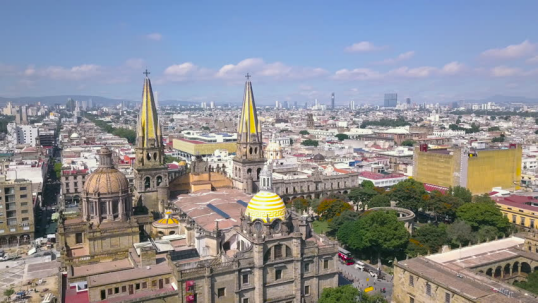
2. Geography and transportation
Topography
Guadalajara's natural wealth is represented by the La Primavera Forest, Los Colomos, and the Barranca de Huentitán. The flora is highlighted by michoacan pines, different species of oak, liquidambar, ash, willows; and introduced trees such as poincianas, jacarandas and ficus, as well as orchids, roses and various species of fungi. The fauna is reduced to the typical urban fauna, in addition to 106 species of mammals, 19 species of reptiles and six species of fish.
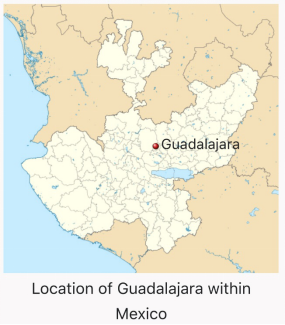
The Barranca de Huentitán
La Barranca de Huentitán (also known as Barranca de Oblatos) is located north of the municipality of Guadalajara. It measures approximately 1,136 hectares and has an average depth of 600 meters difference. The difference in altitudes of the highest contour (1520 m) and the lowest (1000 m) is 520 meters at the point of the funicular rail. This canyon is also named Oblates-Huentitan because it crosses 2 areas of the city called Oblates and Huentitan respectively. From the nineteenth century in the time of the Spanish conquest, there were fights between the Indians of Huentitán and the Spanish. It was also the site of battles during the Mexican Revolution and rebellion.
The Huentitán canyon is considered a biogeographic corridor as it houses four types of vegetation: deciduous tropical forest, gallery forest, heath vegetation and secondary vegetation. There are also several endemic species of flora and fauna in the area. The ravine is frequented by national and international researchers as it is home to a great biological diversity due to its geographical location. On June 5, 1997 it was declared a Protected Natural Area, under the category of Area Subject to Ecological Conservation. La Cascada Cola de Caballo: it is located on the Guadalajara to Zacatecas road (km 15) a few kilometers from the Northern Peripheral just after passing the village of San Esteban. The waterfall consists of a current from the Atemajac Valley but now, being so close to Guadalajara and a colony with very little development, it is very polluted. Urban forest or colomos forest, where the Japanese garden is located, located in the northwestern part of Guadalajara. It is located in one of the areas of greatest value, making it impossible to preserve its original surface. It was one of the main sources of supply of the city, and today continues to provide that vital liquid to some surrounding colonies. Currently, this forest has 92 hectares of forest mass in which pine trees, eucalyptus trees and cedars stand out. It has interesting and varied attractions such as: jogging tracks, gardens, ponds, bird lake, areas for field day, playgrounds, camping, horses. Other places include: Camachos Aquatic Natural Park. Barranca de Huentitlán La walnut. Barranca de Oblatos, Barranca Colimilla or Rio Grande, Japanese Garden in the forest of settlers.
Parks
Parks and forests are important in Guadalajara; of the three most important cities in Mexico, it has the most green areas and plants. Not all are found in the city of Guadalajara, but are distributed in the Metropolitan Zone of Guadalajara (ZMG).
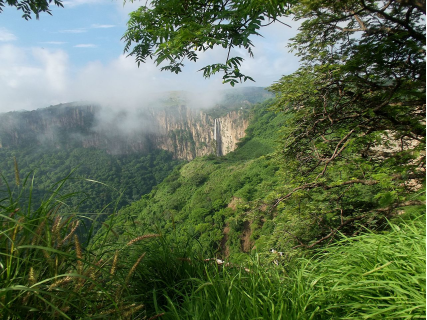
Los Colomos urban forest, where the Japanese garden is located, located in the northwest part of Guadalajara. Located in one of the areas of greatest value, making it impossible to preserve its original surface. It was one of the main sources of supply of the city, today it continues to provide that vital liquid to some surrounding colonies. Currently, this Forest has 92 hectares with a forest mass in which the pines, eucalyptus trees and cedars stand out. It has interesting and varied attractions such as: jogging tracks, gardens, ponds, bird lake, areas for field day, playgrounds, camping, and horses.
Transportation
Guadalajara is well connected by a number of modern highways. These include Fed 15, which connects the city northwestward to Nogales, Sonora, via Tepic, Nayarit and eastwards to Mexico City via Morelia; Fed 80D which runs northwest toward Aguascalientes; and Fed 54D which runs southward to the coast via Colima. The city's well connected transportation infrastructure allows easy access to Mexico City, to the northwest and to the major beach resorts of Manzanillo, Mazatlán and Puerto Vallarta to the southwest, northwest, and west, respectively.
Guadalajara International Airport
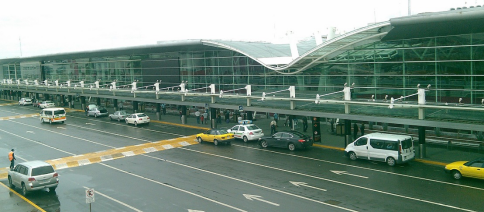
The Miguel Hidalgo y Costilla Guadalajara International Airport, also known as Guadalajara International Airport (ICAO code: MMGL) opened in 1966. It is located 16 km (10 mi) south of downtown Guadalajara, and it was built on the Tlajomulco de Zuñiga city, near Chapala. The airport is the third most active in the country (after Mexico City and Cancún) with direct flights to many Mexican and American cities.
Within the city itself, there are many forms of public transportation. The Guadalajara light rail/metro system, named SITEUR (Sistema de Tren Eléctrico Urbano), Spanish for Urban Electrical Train System, provides rapid transit service within Guadalajara and the neighboring municipalities of Zapopan and Tlaquepaque. It consists of two lines: line 1, running from north to south, with 19 stations, and line 2, running from downtown to the east, with 10 stations. The trains are electric and have a top speed of 70 km/h (43 mph). The 48 articulated cars currently in service were built in Mexico by Concarril/ Bombardier. Construction on a third line began in 2014. Line 3 will run from Zapopan, in the northwest, to Tlaquepaque and Tonalá, in the southeast, via the city center.
The Guadalajara Macrobus is a public transportation system based on the concept of Bus Rapid Transit, where each bus has a single route and boarding station. Phase I of the Macrobús project opened in 2009 with a 16-kilometre-long (9.9 mi) corridor following Calzada Independencia and serving 27 stations. The Guadalajara trolleybus system has been operating since the 1970s, along with many city buses run by private companies and a bustling network of pedestrianised streets.
Guadalajara bike-sharing system.
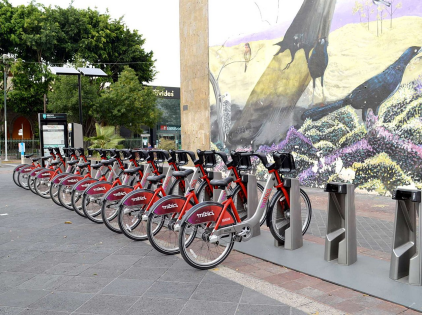
Mi Bici Pública, PBSC Urban Solutions-based public bike share system, was launched in 2014. In 2016, the city implemented 242 docking stations and 2116 bikes. As of September 2018 Mi Bici has 19,664 annually subscribed users.
3. Economy
Guadalajara is the third largest GDP in Mexico, and possesses one of the best infrastructures for industrial development in the country; it contributes thirty-seven percent to the state of Jalisco’s total gross production.
The city’s economy is based on two main sectors: commerce/tourism and industry. While commerce and tourism employ about 60% of the population, industry, manufacturing, in particular, have been a main engine of economic growth and the basis of Guadalajara’s economic importance nationally.
Economic development
During each government period, the city went through structural plans with which new areas and commercial hubs were born and with which transnational corporations and international industries arrived in the city. The city housed the first shopping malls in Mexico.
The city expanded rapidly before merging with the Zapopan municipality. Among the developments created during this period were the Guadalajara Expo, the light rail, shopping centers, the expansion of streets and avenues, and the birth and development of road infrastructure, services, tourism, industrial, etc. The first shopping center in Latin America emerged in the city, the first urban electric-train system in Latin America, and the first autonomous university in Mexico.
A 2007 survey entitled "Cities of the Future", FDi magazine ranked Guadalajara first among major Mexican cities and second among major North American cities in terms of economic potential, behind Chicago. The magazine also rated it as the most business-friendly Latin American city in 2007.
Foreign trade
Most of Guadalajara's economic growth since 1990 has been tied with foreign investment. International firms have invested here to take advantage of the relatively cheap but educated and highly productive labor, establishing manufacturing plants that re-export their products to the United States, as well as provide goods for the internal Mexican market.
A media report in early October 2013 stated that five major Indian IT (information technology) companies have established offices in Guadalajara, while several other Indian IT companies continue to explore the option of expanding to Mexico. Due to the competitiveness in the Indian IT sector, companies are expanding internationally and Mexico offers an affordable opportunity for Indian companies to better position themselves to enter the United States market. The trend emerged after 2006 and the Mexican government offers incentives to foreign companies.
Exports from the city went from US$3.92 billion in 1995 to 14.3 billion in 2003. From 1990 to 2000, socio-economic indicators show that quality of life improved overall; however, there is still a large gap between the rich and the poor, and the rich have benefited from the globalization and privatization of the economy more than the poor.
International investment has affected the labor market in the metro area and that of the rural towns and villages that surround it. Guadalajara is the distribution center for the region and its demands have led to a shifting of employment, from traditional agriculture and crafts to manufacturing and commerce in urban centers. This has led to mass migration from the rural areas to the metropolitan area.
4. Industries and enterprises
commercial sector
Most of the economy revolves around commerce, employing 60% of the population. This activity has mainly focused on the purchase and sale of the following products: food and beverages, textiles, electronic appliances, tobacco, cosmetics, sport articles, construction materials and others. Guadalajara's commercial activity is second only to Mexico City.
The city is the national leader in the development and investment of shopping malls. Many shopping centers have been built, such as Plaza Galerias, one of the largest shopping centers in Latin America, and Andares. Galerías Guadalajara covers 160,000 m2 (1,722,225.67 sq ft) and has 220 stores. It contains the two largest movie theaters in Latin America, both with IMAX screens. It hosts art exhibits and fashion shows, and has an area for cultural workshops. Anchor stores includes Liverpool and Sears and specialty stores such as Hugo Boss, Max Mara and Lacoste, Tesla MotorsCostco. Best Buy opened its first Guadalajara store here. It has an additional private entrance on the top floor of the adjacent parking lot. Another Best Buy store was inaugurated in Ciudadela Lifestyle Center mall, which was the chain's third-largest in the world, according to the company.
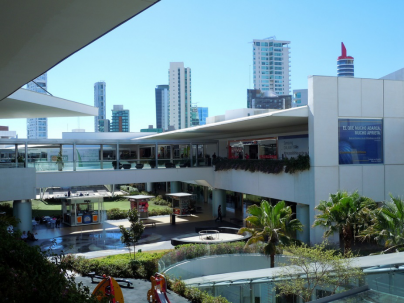
Andares Shopping Mall
Andares is another important commercial center in Zapopan. This $530 million mixed-use complex opened in 2008, designed by renowned Mexican Sordo Madaleno architecture firm features luxury residences and a high-level mall anchored by two large department stores, Liverpool and El Palacio de Hierro. The 133,000 m2 (1,400,000+ sq ft) mall offers hundreds of stores, a big food court located on the second floor and several restaurants at the Paseo Andares.
A large segment of the commercial sector caters to tourists and other visitors. Recreational tourism is mainly concentrated in the historic downtown. In addition to being a cultural and recreational attraction and thanks to its privileged geographical location, the city serves as an axis to nearby popular beach destinations such as Puerto Vallarta, Manzanillo and Mazatlán. Other types of visitors include those who travel to attend seminars, conventions and other events in fields such as academic, entertainment, sports and business. The best-known venue for this purposes is the Expo Guadalajara, a large convention center surrounded by several hotels. It was built in 1987, and it is considered the most important convention center in Mexico.
Sector of technology
The electronics and information technology sectors that have nicknamed the city the "Silicon Valley of Mexico". Guadalajara is the main producer of software, electronic and digital components in Mexico. Telecom and computer equipment from Guadalajara accounts for about a quarter of Mexico's electronics exports. Companies such as General Electric, IBM, SANMINA, Intel Corporation, Freescale Semiconductor, Hitachi Ltd., Hewlett Packard Enterprise, HP Inc, Siemens, Flextronics, Oracle, Wipro, TCS, Cognizant Technology Solutions and Jabil Circuit have facilities in the city or its suburbs. This phenomenon began after the passage of the North American Free Trade Agreement (NAFTA). International firms started building facilities in Mexico, especially Guadalajara, displacing Mexican firms, especially in information technology. One of the problems this has created is that when there are economic downturns, these international firms scale back.
5. Landmarks and monuments of Guadalajara
Hospicio Cabañas
The Hospicio (Museo) Cabañas in Guadalajara, Jalisco, Mexico, a World Heritage Site, is one of the oldest and largest hospital complexes in the Americas.
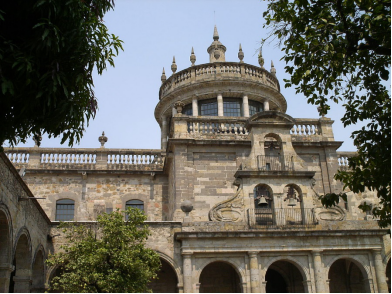
Basilica of Our Lady of Zapopan
The Basilica of Our Lady of Zapopan and the abbey of Our Lady of Expectation of Zapopan are a 17th-century Franciscan sanctuary built in downtown Zapopan, in the state of Jalisco, México.
It is one of the most visited sanctuaries in Western Mexico, and it preserves a wooden Virgin that is considered a valuable relic of medieval origin, which came from Spain to New Galicia in the 16th century. The Huichol Museum is located in the building.
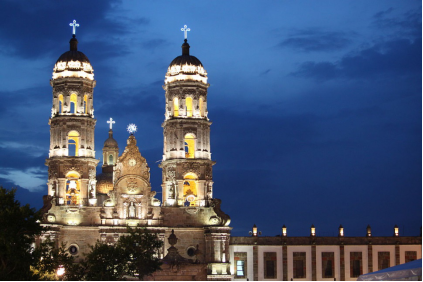
Templo Expiatorio del Santísimo Sacramento
The Templo Expiatorio del Santísimo Sacramento is a Catholic church dedicated to the Blessed Sacrament, located in Guadalajara, Jalisco, Mexico. The church is of neo-Gothic style and is considered the greatest work of its kind in Mexico. Its construction began on August 15, 1897 and ended 75 years later in 1972.
The church is made mostly of stone, carved as it was done in the Middle Ages. The huge, stained glass windows, including the rosette on the facade, were executed by Jacques and Gerard Degusseau of Orléans, France, according to cartons of the artist Maurice Rocher of Paris.
6. History and culture
History
Guadalajara history began with the conquest of Mexico by Spain. In 1532, Mesa del Cerro (now known as Nochistlan, Zacatecas) was established as the first settlement of Guadalajara. The site was settled by Cristobal de Onate and commissioned by Nuno de Guzman to secure recent Spanish conquests and defend against the indigenous tribes. The settlement disbanded in 1533 because of lack of water and was moved to a location near present day Tonala. Four years later, Guzman ordered the village be moved again, this time to Tlacotan. Finally, on February 14, 1542, the city of Guadalajara was founded at its current site.
Guadalajara’s name comes from the Arab word, “wad-al hidjara,” meaning “river that runs between rocks.”
Throughout the 17th and 18th centuries, Guadalajara increased its wealth and influence by importing goods from the Pacific coast and distributing them to the rest of Mexico. The region also achieved greater stability by negotiating peaceful settlements with the indigenous tribes.
In 1791, the University of Guadalajara was established in the city, which was then the capital of the state of Nueva Galicia. The inauguration was held in 1792. Guadalajara became the capital of the new State of Jalisco on May 27, 1824, following Mexico’s war of Independence from Spain.
Guadalajara prospered in the 19th century. Small-scale industries began developing, many started by immigrants from Europe. Rail lines were laid to connect Guadalajara to the Pacific coast and north to the United States, which allowed agricultural products from the region to be shipped to markets. Ranching became a very important part of the area’s economy at that time.
Beginning in the 1930s, Guadalajara began experiencing major growth and exceeded 1 million people by the 1960s. By the 1970s, the city was second in population only to Mexico City.
Guadalajara underwent a major transformation in the 1950s, replacing outdated buildings with modern architecture, creating wider streets for pedestrians and adding underground parking lots and new shopping centers. The wise city fathers kept the beautiful old buildings you can see today that portray the history and character of Guadalajara.
A major disaster struck the city in 1992, when Guadalajara experienced a major gasoline explosion in the sewer system that killed 206 people, injured nearly 500 and left 15,000 homeless. The damage was estimated at nearly US$1 billion.
Today, Guadalajara is a vibrant metropolitan area of 4.4 million people with a thriving economy built on electrical and electronic products and beer production. The city is called Mexico’s Silicon Valley and is home to many high technology firms like IBM, Kodak, General Electric, Dell, Hewlett Packard, Siemens, Flextronics, Gateway, Hitachi, Solectron and others.
Culture
The cultural life in Guadalajara is one of the widest in the hemisphere. The city has one of the largest cultural agendas on the continent, in addition to the interest of the government, the University of Guadalajara and private institutions, to underline the cultural attributes of the city and the State of Jalisco. The city exhibits works by international artists and is a must-see for international cultural events whose radius of influence reaches most of the countries of Latin America, including the southwestern United States.
Guadalajara's historic center is designed on a Spanish colonial street grid.
Its historic center houses colonial buildings of a religious and civil character, which stand out for their architectural and historical significance, and constitute a rich mixture of styles whose root is found in indigenous cultural contributions (mainly of incorporated into the Mozarabic and the castilian), and later in modern European influences (mainly French and Italian). The historic center also has an excellent infrastructure of museums, theatres, galleries, libraries, auditoriums and concert halls. Some of these buildings date from the sixteenth and seventeenth century, such as the Cathedral of the Archdiocese of Guadalajara, among others. In terms of media, the city has several radio stations focused on culture, being [Red Radio University of Guadalajara (XHUG-F) one of the most important and the one that is transmitted to the rest of the state and neighboring states and internationally through the Internet; it is also the first broadcaster via Pod Cast in the country, the city produces a fully cultural channel; XHGJG-TV dedicated to support, dissemination, and cultural entertainment and broadcast on open television, Guadalajara being the only city to produce a cultural cutting channel in the country in addition to the Mexico, D.F.A. Mexico City. Guadalajara publishes the most important cultural magazine in the country.
7. Other information
The city has hosted numerous important international events, such as the first Cumbre Iberoamericana in 1991; the Third Summit of Heads of State and Governments of Latin America, the Caribbean and the European Union in 2004; the Encuentro Internacional de Promotores y Gestores Culturales in 2005; and the 2011 Pan American Games. It was named the American Capital of Culture in 2005 and the Ciudad Educadora (Educator City). in 2006. It was recognized as Mexico's first Smart City due to its use of developing technology. During each government period, the city went through structural plans with which new areas and commercial hubs were born and with which transnational corporations and international industries arrived in the city. The city housed the first shopping malls in Mexico.
Guadalajara has acquired the nickname of the “Silicon Valley of Mexico” by the electronics and information technology sectors, because it is the main producer of software, electronic and digital components in Mexico.
Guadalajara was selected as "Smart City" in 2013 by IEEE, the world's largest professional association for the advancement of technology.
The Secretariat of Communications and Transportation also reported that Guadalajara, Jalisco was chosen as the official venue for the first "Digital Creative City of Mexico and Latin America", what will be the spearhead for our country to consolidate the potential in this area.
Guadalajara was the first Mexican city to be accepted as a member of the International Association of Educational Cities due to its strong character and identity, potential for economic development through culture.
8. Contact Information
Mayor: Ismael Del Toro Castro
Website: https://guadalajara.gob.mx/
Facebook: @GuadalajaraGob
Tel: +52 3837-4400
Email: contacto@guadalajara.gob.mx
Office address:
Av. Miguel Hidalgo y Costilla 400, Zona Centro, 44100 Guadalajara, Jal., México
